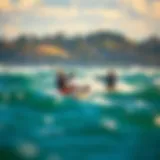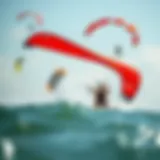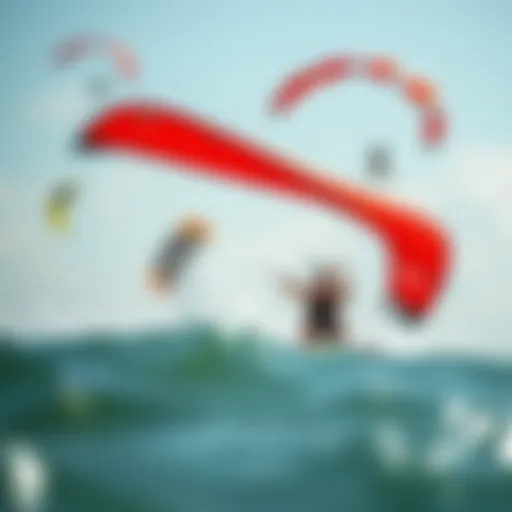Kitesurfing Adventures in Aruba: Your Ultimate Guide
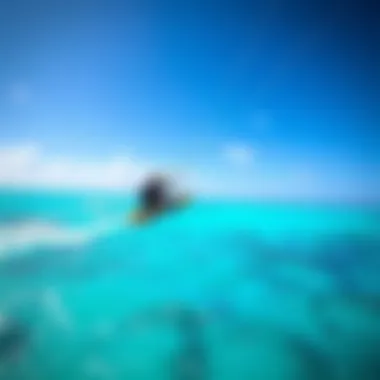

Intro
Kitesurfing in Aruba presents an exhilarating combination of wind, sea, and adventure. For those drawn to the rush of gliding across clear turquoise waters while being propelled by the wind, Aruba stands as a premier destination. The island boasts favorable wind conditions, stunning beaches, and a vibrant culture that enriches the entire experience. Whether you are a novice eager to learn the ropes or a seasoned pro looking for that sweet spot, Aruba's kitesurfing scene offers all that and more.
The island’s diverse spots cater to every level of skill, from wide-open spaces perfect for beginners to challenging conditions that can test the mettle of experts. This guide aims to illuminate the paths of kitesurfing in Aruba by examining key locations, essential gear, and the tips that can elevate your time on the water. We will also touch on the local culture that breathes life into the sport, making your adventure not just about riding the waves but about joining a welcoming community.
In this article, we will cover:
- Prime locations for kitesurfing across Aruba
- Optimal wind conditions to enhance your experience
- Essential gear and maintenance for your equipment
- Techniques suitable for both beginners and advanced kitesurfers
- The intertwining local culture that surrounds this exhilarating sport
Stay tuned as we navigate the ins and outs of kitesurfing in Aruba, and get ready to grab your gear for what is bound to be an unforgettable escapade.
Prelude to Kitesurfing in Aruba
Kitesurfing in Aruba is more than just a sport; it’s a thrilling blend of adrenaline, freedom, and connection to nature. The island’s unique characteristics, from its brisk winds to turquoise waters, make it a standout destination for both seasoned kitesurfers and curious beginners looking to try their hand at this exhilarating activity. This guide aims to illuminate the vital components of kitesurfing in Aruba, showcasing how the island captivates enthusiasts from around the world.
Why Kitesurfing?
Kitesurfing is not just about riding the waves; it’s an experience that encapsulates the thrill of harnessing wind power. The rush of speed combined with the lucent sea backdrop offers a one-of-a-kind adventure that’s hard to find elsewhere. For Aruba, with its consistent winds and conducive climate, kitesurfing serves as a prime activity that blends sportsmanship with scenery.
Benefits of Kitesurfing in Aruba
First off, kitesurfing in Aruba offers numerous benefits:
- Ideal Conditions: The island is blessed with steady winds, making it perfect for kiting almost year-round.
- Varied Spots: Aruba's diverse coastline allows kitesurfers to choose their preferred riding style, whether they’re after flat water or waves.
- Community and Culture: The kitesurfing community here is tight-knit and welcoming, offering numerous events that celebrate the sport and local culture.
- Accessibility: With various schools and instructors available, kitesurfing is accessible to all, regardless of skill level.
Considerations Before You Dive In
While the allure of kitesurfing in Aruba is undeniable, there are some factors to consider:
- Experience: If you’re new to kitesurfing, enrolling in lessons is highly recommended. Local instructors are well-versed with the nuances of Aruba's conditions, which can be quite different than those in other places.
- Equipment Knowledge: Familiarity with different types of kites and boards is essential for safety and enjoyment. Understanding your gear enhances your experience.
- Weather Awareness: While Aruba generally enjoys good weather, being aware of changing conditions can ensure a safer experience.
"Kitesurfing transforms the ocean into a playground, where the horizon is the limit and the wind is your ally."
In summation, kitesurfing in Aruba is an exciting pursuit that encourages adventure. The island's natural beauty and optimal conditions create the perfect backdrop for both relaxation and exhilaration. This article will guide you through all aspects of kitesurfing on the island, ensuring that you embark on this journey equipped with valuable insights and tips. From the best spots to the essential gear needed, we’ll cover everything necessary for a fruitful experience.
Whether you’re a trip-hardened kiteboarder or a greenhorn eager to catch your first breeze, the charms of kitesurfing in Aruba are calling your name.
Geographical Advantages of Aruba
Kitesurfing in Aruba is more than just a thrilling sport; it leverages the island's unique geographical features that make it a premier destination for enthusiasts. Understanding what makes Aruba a top kitesurfing spot helps both beginners and seasoned riders make the most of their experience.
The Island's Wind Patterns
Aruba is located just above the equator, which positions it perfectly to capture steady trade winds. Typically, these winds blow consistently from the east, ranging from 15 to 25 knots—ideal conditions for kitesurfing. Riders will find that these winds are not only dependable but also create an exhilarating experience, allowing for dynamic aerial maneuvers.
The winds in Aruba tend to be strongest between late December and July, aligning perfectly with the peak kitesurfing season. This blend of consistent winds and tropical climate ensures that kitesurfers can enjoy optimal conditions almost every day. Such predictability in wind patterns means that both learners and experts can schedule their kitesurfing sessions without worrying about sudden weather changes that might affect their ride.
Water Clarity and Conditions
The waters surrounding Aruba are renowned for their clarity, a significant boon for kitesurfers. Crystal-clear turquoise water offers not only aesthetic pleasure but also contributes to a safer kitesurfing experience. Visibility beneath the surface means that riders can clearly spot any potential obstacles like coral reefs or sea urchins, reducing the chances of accidents.
Moreover, the surf conditions are usually gentle due to the protective barrier reefs, which helps form ideal flat water areas. These flatter sections are especially favorable for beginners, as they allow for easier navigation and control. In contrast, seasoned kitesurfers can also find exciting waves along specific shores, catering to varied preferences within the kitesurfing community.
Coastal Topography
The coastal layout of Aruba serves as yet another geographical advantage. With a mix of sandy beaches, rocky shorelines, and open bays, kitesurfers can choose different spots that match their skill level. Beaches like Boca Grandi boast expansive sandy areas and open water spaces that are perfect for launching kites and riding.
The island's diverse coast ensures ample room for kitesurfers of all styles, from freestyle to wave riding. It's not uncommon to see a group of seasoned pros executing aerial stunts while just a short distance away, learners are perfecting their basics in calmer waters. This unique blend of environments promotes a vibrant kitesurfing culture that fosters community and encourages camaraderie among enthusiasts.
Top Kitesurfing Spots in Aruba


Kitesurfing in Aruba offers not just thrilling wind sports, but also picturesque settings. Knowing where to go can elevate the kitesurfing experience tremendously. Each location has its own set of features that can cater to different skill levels and preferences. When checking out these spots, one should consider factors such as local wind conditions, safety measures, and accessibility.
Boca Grandi
Boca Grandi is a gem known for its consistent trade winds. Located on the northeastern side of the island, it’s popular among advanced riders. The open expanse of the sea here means that riders have plenty of room to carve up the water. The beauty of Boca Grandi lies in its shallow areas and the opportunity to perform tricks without much hassle. However, it's best for experienced kiteboarders since waves and wind can be unforgiving for novices. Remember, with great thrill comes great responsibility.
"Boca Grandi offers kitesurfers a vast canvas of wind and water. Here, you're not just surfing; you’re painting your adventure with every glide."
Hadicurari Beach
Hadicurari Beach is somewhat of a kitesurfing mecca, especially for those just dipping their toes into the sport. The beach boasts a friendly vibe, with instructors frequently seen guiding newcomers. The warm, shallow waters here provide a safe environment for beginners to build their confidence. As you improve, you can explore more challenging areas nearby. Plenty of rental shops make getting gear hassle-free. The sunsets at Hadicurari are just a cherry on top—a view that takes your breath away after a long day on the water.
Fisherman’s Huts
Fisherman’s Huts is known as that laid-back spot where locals and tourists intermingle. The atmosphere is relaxed, perfect for those who want to enjoy a less commercial vibe. The kitesurfing conditions here suit both beginners and intermediate riders. There’s a natural beauty surrounded by beautiful palm trees and white sands. Fisherman’s Huts also serves incredible local food, making it easy to refuel after a long session. This is a place where one can enjoy the waves and savor the island’s true culture in one go.
De Palm Island
A visit to De Palm Island isn't just about the kitesurfing; it's an entire package of adventure and relaxation. This small paradise offers premium experiences for enthusiasts who are ready to take the plunge. The water sports center here is highly equipped and provides rental gear, lessons, and guided kitesurfing expeditions. The environment is secured from the rougher seas due to its surrounding reefs, making it a comfortable location for all skill levels. Plus, don't forget to take a stroll on the island to soak in the scenery—it's breathtaking.
Optimal Kitesurfing Conditions
Understanding the optimal conditions for kitesurfing is crucial for anyone looking to enjoy a successful day on the water. It can mean the difference between a thrilling ride and an experience fraught with challenges. From wind patterns to tide fluctuations and weather conditions, each element plays a significant role in shaping the kitesurfing experience in Aruba.
Best Months for Kiting
In Aruba, the prime kitesurfing season typically runs from November to June. During these months, trade winds dominate the area, consistently blowing between 15 to 25 knots. These steady winds create ideal conditions for kiteboarding, which is indispensable for both beginners learning the ropes and intermediates honing their skills.
- November to February: This period offers the strongest winds. Your kite can soar beautifully through the air as the robust currents make it easier to catch air and perform tricks.
- March to June: While winds begin to mellow slightly, they still present favorable conditions, making it a great time for those looking to refine their technique without the overpowering winds.
Keep in mind, though, conditions can vary with seasons, so it’s wise to check local forecasts before heading out.
Tide Variables
Tide patterns can shift dramatically in Aruba and influence not only the water level but also the kiteboarding spots. Understanding how tides affect waves is essential for both safety and performance. Kitesurfers should note the following:
- High Tide: Often creates flat water, which is ideal for beginners. This is when you can learn new skills without the interference of breaking waves.
- Low Tide: Tends to expose sandbars and reef structures. While experienced riders might enjoy the challenge, beginners should be cautious of potential hazards.
The tidal range in Aruba is about 1.5 feet, so knowing the schedule helps. You can follow the local tide charts published on authoritative sites or local social media channels.
Weather Influences
Weather patterns in Aruba generally favor kitesurfing, but local variations can still occur. Strong storms can develop rapidly, causing gusty winds and unpredictable seas. Some weather aspects to keep an eye on include:
- Cloud Cover: A cloudy day can sometimes lead to variable wind conditions, meaning it’s prudent to choose days with clearer skies for a steadier blow.
- Temperature: While comfortable for riding, water temperatures fluctuate, which may impact gear choices. Knowing the local climate stats can prepare you better for each outing.
Be sure to keep an eye on forecast tools like Windy (windy.com) or the Weather Channel (weather.com) for real-time updates.
Key Insight: Always prioritize safety. If the weather looks questionable, it might be best to skip out for the day.
By understanding these factors and preparing accordingly, kitesurfers can maximize their enjoyment and performance out on the water. Preparing for the right conditions leads to an unforgettable experience, whether you are a beginner or a seasoned pro.
Essential Gear for Kitesurfing
When it comes to kitesurfing, the right gear can make or break your experience on the water. Understanding the ins and outs of essential equipment can not only enhance your performance but also ensure your safety, allowing you to fully embrace the thrill of this captivating sport. From kites to boards, harnesses to safety gear, each piece plays a significant role in your kitesurfing journey.
Kites: Types and Sizes
Kites are arguably the most crucial component of your kitesurfing setup. They come in various shapes, sizes, and materials, each designed for specific conditions and rider preferences. The most common types include:
- C-Kites: These kites offer excellent power and upwind performance, ideal for freestyle and advanced maneuvers.
- Bow Kites: Bow kites generate a large wind range and provide a smoother ride, making them popular among beginners and those looking to improve their skills.
- Delta Kites: These are versatile and stable, suitable for various weather conditions, striking a balance between performance and ease of control.
When it comes to size, kites typically range from 5 to 18 square meters. Considerations for choosing the right size include your weight, wind conditions, and riding style. For instance, lighter riders may opt for smaller kites in high winds, while heavier individuals might choose larger kites in lighter wind conditions.
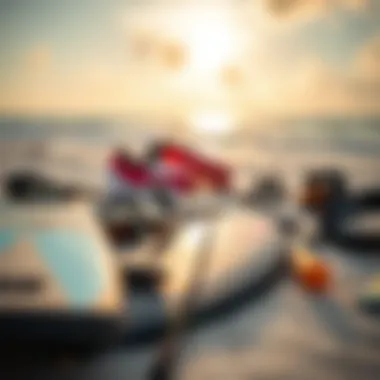

Boards: An Overview
The board is another key element in your kitesurfing setup. Boards differ in shape, size, and construction, affecting performance and style. Here are some common types:
- Twin-Tip Boards: The most popular design, twin-tips are symmetrical, allowing riders to go in either direction. They're great for tricks and jumps.
- Directional Boards: These boards resemble surfboards and are designed for downwind riding. They're preferred by those who enjoy riding waves.
- Foil Boards: For those looking for a different experience, foil boards lift above the water, providing a unique sensation and enabling riding in lighter winds.
Selecting the right board depends on your individual riding style and the conditions you'll be encountering in Aruba. Pay attention to the board's rocker and width, as these facets influence speed and maneuverability.
Harness Selection
A good harness can dramatically improve comfort and control while kitesurfing. There are two primary types of harnesses:
- Waist Harnesses: These are more popular among kitesurfers because they offer freedom of movement. They sit around your waist and distribute forces evenly across your body, making them suitable for most riding styles.
- Seat Harnesses: Ideal for beginners or those who prefer additional support, seat harnesses provide more back support and keep the torso upright. However, they can restrict movement more than waist harnesses.
When choosing a harness, consider factors like fit, support, and personal comfort. It's essential to try on different options to find what suits you best.
Safety Equipment
Safety should always be a priority in kitesurfing. Essential safety gear includes:
- Helmet: Protects against head injuries caused by falls or impacts.
- Impact Vest: Offering buoyancy and protection, an impact vest can be a lifesaver. It cushions against hard landings and adds warmth in cooler waters.
- Safety Leash: This connects the kite to the rider, allowing for a quick release in case of an emergency.
Using reliable safety equipment reduces risks and promotes confidence on the water. It's worth investing in high-quality gear to ensure a secure kitesurfing experience.
"Regularly inspect your gear for damage to maintain safety and performance. It’s better to have safe gear than to take unnecessary risks."
In summary, having the right gear is paramount for an enjoyable and safe kitesurfing experience. Each component is designed to contribute to your ability to maneuver, control, and most importantly, enjoy your time on the water. Before hitting Aruba’s waves, ensure you understand your gear and how it works together. This knowledge will not only boost your confidence but also enhance your overall kitesurfing experience.
Safety Tips for Kitesurfers
Ensuring safety while kitesurfing in Aruba is not just about protecting oneself; it’s also about making sure the sport remains enjoyable for everyone involved. When the wind is up, the thrill of the ride can overshadow crucial safety measures, which are vital for both new and seasoned kitesurfers. Understanding the nuances of kite control, acknowledging potential local hazards, and being prepared for emergencies are foundational to this adventure sport. Knowing these aspects can transform a good kitesurfing outing into a great one, keeping the good times rolling while minimizing risks.
Understanding Kite Control
Mastering kite control is at the heart of kitesurfing, and it goes beyond just knowing how to maneuver a kite. It’s about developing a keen sense of how the kite interacts with wind currents and how the pilot’s movements affect its flight. An experienced kitesurfer knows that even a slight adjustment in the position can lead to significant changes in lift and direction.
Here are some key elements regarding kite control:
- Positioning: Always start with the kite at 12 o'clock in low winds. This position helps beginners to get a feel for handling the kite without immediate danger.
- Trimming Lines: Regularly adjust your lines so they’re properly trimmed for your weight, the kite size, and wind strength. This simple step ensures that you can control your kite efficiently.
- Communication: If you're riding with others, signaling with hand gestures can be a lifesaver. Let others know your intended movements before executing them to avoid collisions.
By keeping a close eye on kite control and practicing consistently, one can enhance their riding experience while ensuring safety on the water.
Local Hazards to Consider
Aruba’s picturesque shores may look inviting, but kitesurfers should remain vigilant about the less glamorous side of this paradise. Local hazards can range from natural features to environmental conditions that could catch an unsuspecting rider off-guard.
- Coral Reefs: The island is blessed with stunning coral reefs, but they pose a threat if one comes too close. These sharp structures can lead to injuries or even damage your kite. Always be aware of your surroundings.
- Strong Currents: Some areas may have unpredictable water currents. It’s critical to know the flows and have an understanding of the local tide patterns before setting off.
- Beach Obstacles: These can include rocks, vessels, or even swimmers. A sharp eye for one’s trajectory and a general awareness of surroundings can prevent accidents.
It’s wise to familiarize oneself with local kitesurfing spots and heed any warnings from local authorities.
Emergency Procedures
While the likelihood of encountering an emergency may be low, it’s always best to have a plan. An ounce of prevention can save a pound of trouble in a sport where conditions can shift in the blink of an eye.
- Signal for Help: If you find yourself in trouble, signal by raising a free hand and waving it swiftly. This alert gesture can draw attention from other kitesurfers or anyone on the beach.
- Knowledge of Local Emergency Contacts: Familiarize yourself with local emergency services and their contact numbers before heading out. This could be a real lifesaver.
- Secure Your Gear: In case of any emergency, quickly secure your kite by releasing it from your harness to avoid entanglement or injury.
"Preparation isn’t just good practice; it's essential for safety."
Kitesurfing Schools and Lessons
When it comes to kitesurfing, having the right foundation is crucial. Kitesurfing schools play an important role in shaping not just skillful riders but also a more informed community. Learning from experts can make the difference between having a fun learning experience and facing potential dangers on the water.
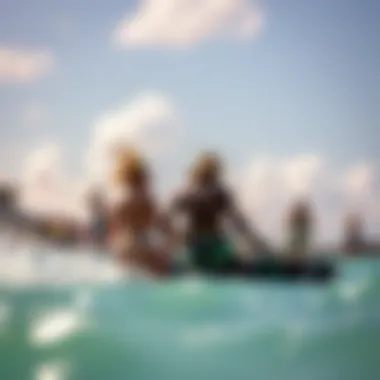

Finding the Right School
Choosing a kitesurfing school is akin to picking a fine wine; you want to ensure it matches your taste and requirements. Here are a few considered steps to guide your decision:
- Reputation: Look for schools with positive reviews and word-of-mouth recommendations. You may find feedback on local forums or Facebook groups dedicated to kitesurfing in Aruba.
- Certifications: Ensure the school follows recognized organizations such as International Kiteboarding Organization. This guarantees that instructors meet safety and teaching standards.
- Facilities: A good school should have rental equipment that is well-maintained, safe, and fits various skill levels. It should also provide safe access to training locations.
- Instructor Experience: The knowledge and experience of your instructor can truly shape your learning curve. Instructors who boast years of experience are often better equipped to handle unforeseen situations on the water.
Beginner Courses Overview
If you're just starting out, enrolling in a beginner course is essential. These courses typically cover:
- Basic Theory: You will learn about wind direction, kite setup, and safety protocols.
- Kite Handling: With hands-on training, you’ll get the feel of a kite in the air, understanding how to control it.
- Water Skill Practice: Many schools offer time in the water, where you can practice body dragging.
A structured course usually spans 3-5 days and offers both practical and theoretical instruction. Make sure you inquire about the course structure and whether it accommodates your specific learning needs.
Advanced Training Opportunities
For kitesurfers looking to take their skills to the next level, advanced training is invaluable. These opportunities typically include:
- Trick & Technique Workshops: Courses focusing on advanced maneuvers, jumping, or riding different types of boards.
- Individualized Coaching: Personalized attention from seasoned instructors who can tailor lessons to suit your specific skills or aspirations.
- Race Training: If competitive kitesurfing is your goal, some schools offer training regimens focused on stances, strategies, and endurance.
Advanced training not only enhances technical skills but also can improve safety awareness and risk assessment during kitesurfing.
"The ocean is a teacher. It is not only about the kitesurfing but also about respect for nature and being adaptable."
Kitesurfing education in Aruba offers the perfect blend of enjoyment and growth in this exciting sport. With a range of schools and programs available, aspiring kitesurfers can find what they need to excel.
Cultural Aspects of Kitesurfing in Aruba
Kitesurfing in Aruba is not just a sport; it's a cultural phenomenon. It intertwines elements of community, tourism, and environmental stewardship, painting a vivid picture of life on this vibrant island. Understanding the cultural aspects surrounding kitesurfing provides a lens into the social fabric of Aruba, revealing how the sport has evolved and enriched the local lifestyle.
Local Community and Events
The local community plays a huge role in shaping the kitesurfing scene. This sport has become a communal activity where people of all ages gather. Classes and events are often organized, bringing kiteboarders together to share tips and foster camaraderie. From beginner workshops to advanced championships, these gatherings elevate the sport and create a sense of belonging among enthusiasts.
During the year, numerous festivals celebrate kitesurfing. One notable event is the Aruba Kitesurfing Championship; it draws both local participants and international contenders, showcasing exhilarating talent on the water. Beyond competitions, community events often incorporate local music and food, giving visitors a taste of Aruban culture while they immerse themselves in kitesurfing.
Impact on Tourism
Kitesurfing significantly boosts Aruba's tourism industry. The island has become a hotspot for adventure lovers seeking pristine waters and consistent winds. Tourists flock to Aruba not just for the beaches but for the thrilling experience of kitesurfing. The influx of kitesurfers contributes to local businesses, including shops selling gear, schools offering lessons, and restaurants providing food and drink to athletes enjoying their day on the water.
More than just economic benefits, kitesurfing helps to promote Aruba as a premier destination for water sports on a global scale. This recognition attracts visitors from far and wide, helping to solidify the island's reputation in the kitesurfing community.
Preserving Natural Resources
With great benefits come great responsibilities. The growing popularity of kitesurfing also raises concerns over environmental sustainability. Local organizers and kitesurfing schools emphasize the importance of preserving Aruba's natural resources. They promote practices that minimize impact on marine life and coastal landscapes.
Many kitesurfers take part in organized clean-up events along the coastline, reflecting a collective commitment to safeguarding the natural beauty that makes kitesurfing in Aruba possible. This proactive approach intertwines the sport with conservation, showing how the kitesurfing community values the environment just as much as they enjoy riding the waves.
"The ocean is not just our playground; it is our responsibility to protect it for future generations."
Kitesurfing in Aruba symbolizes a harmonious relationship between sport, culture, and ecology. As this island community continues to thrive, so does its commitment to ensuring that kitesurfing can be enjoyed by many generations to come.
The End: The Future of Kitesurfing in Aruba
Kitesurfing in Aruba is not just a recreational activity. It's a burgeoning sport that embodies a unique blend of adrenaline, skill, and connection with nature. As we look towards the future of kitesurfing on the island, it's crucial to consider various factors that will shape the sport's development and sustainability.
Sustainability in Practice
The concept of sustainability has gained traction worldwide, and it's particularly vital in the context of Aruba's delicate marine ecosystem. Kitesurfers and the local community must unite to preserve these natural resources, ensuring that the sport can thrive for generations to come.
One effective approach is the promotion of eco-friendly kitesurfing practices. These may include:
- Using biodegradable materials for gear: Manufacturers are starting to explore sustainable materials in equipment production. This could reduce the environmental footprint and encourage others to follow suit.
- Implementing clean-up events: Local kitesurfing schools and enthusiasts can organize beach clean-ups, fostering a sense of community while keeping the coastlines pristine. It promotes awareness among the kitesurfing population of their impact on the environment.
- Educating riders on local ecosystems: Many kitesurfers come from different backgrounds and regions. Sharing knowledge about Aruba's natural habitats can cultivate a deeper respect and understanding for the environment.
- Encouraging sustainable tourism: Tour operators can work to highlight eco-tourism as an attractive option, further integrating kitesurfing into the broader narrative of ecological responsibility.
Furthermore, local legislation plays a critical role too. Government initiatives aimed at regulating water sports can help manage the number of kitesurfers in specific areas, alleviating pressure on delicate ecosystems and providing guidelines that don't restrict the sport's growth but protect its surroundings.
"The balance between thrill-seeking and environmental stewardship is key to ensuring that Aruba's kitesurfing scene continues to flourish."
As the sport continues to gain popularity, it’s essential to bolster insights within the kitesurfing community about the long-term benefits of sustainable practices. This collective commitment can create a lasting legacy for Aruba as a premier kitesurfing destination. Through collaboration and mindful practices, kitesurfing can remain an exhilarating experience while protecting the paradise that makes it so special.
